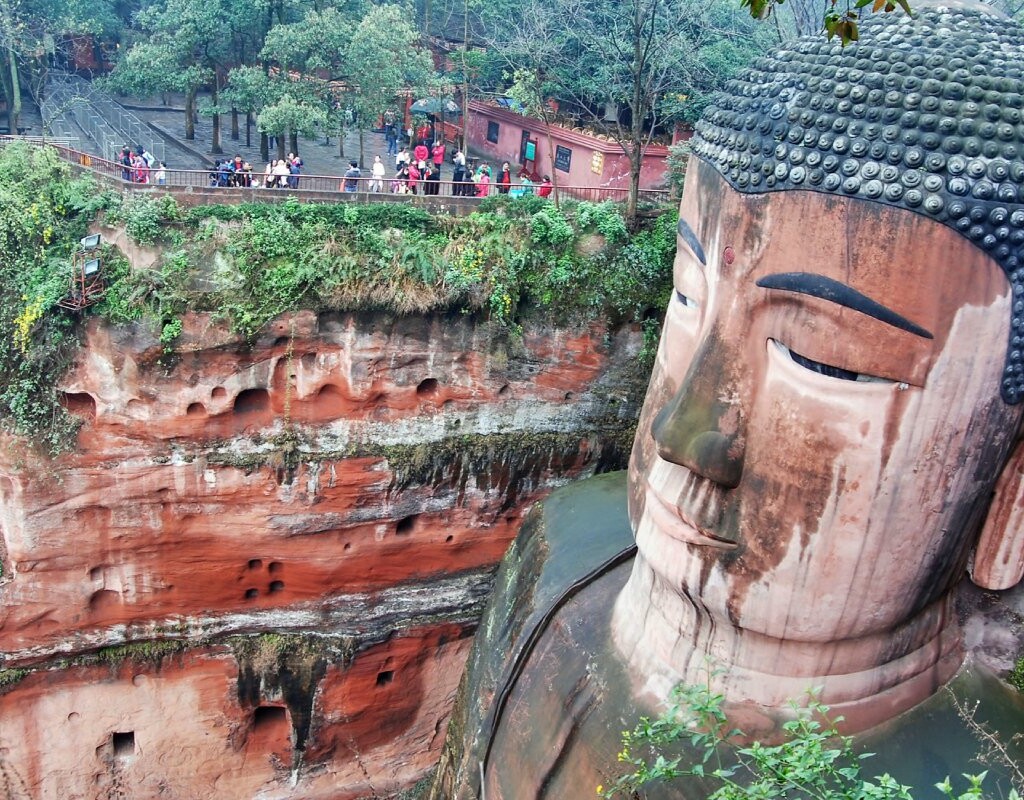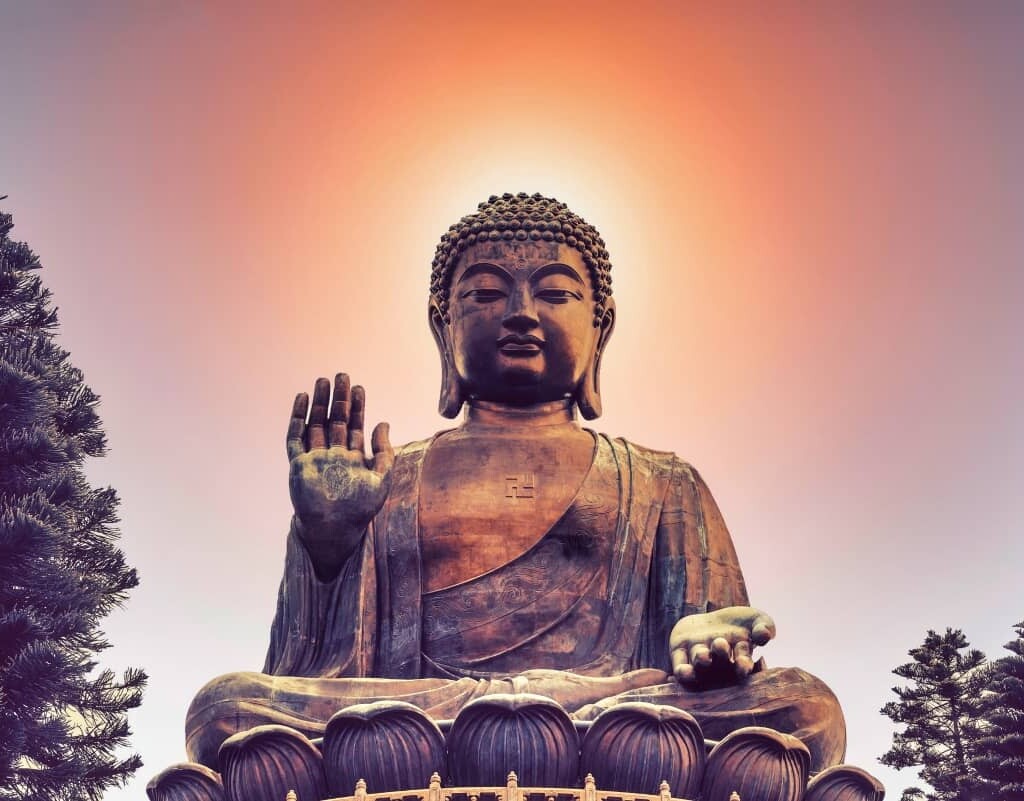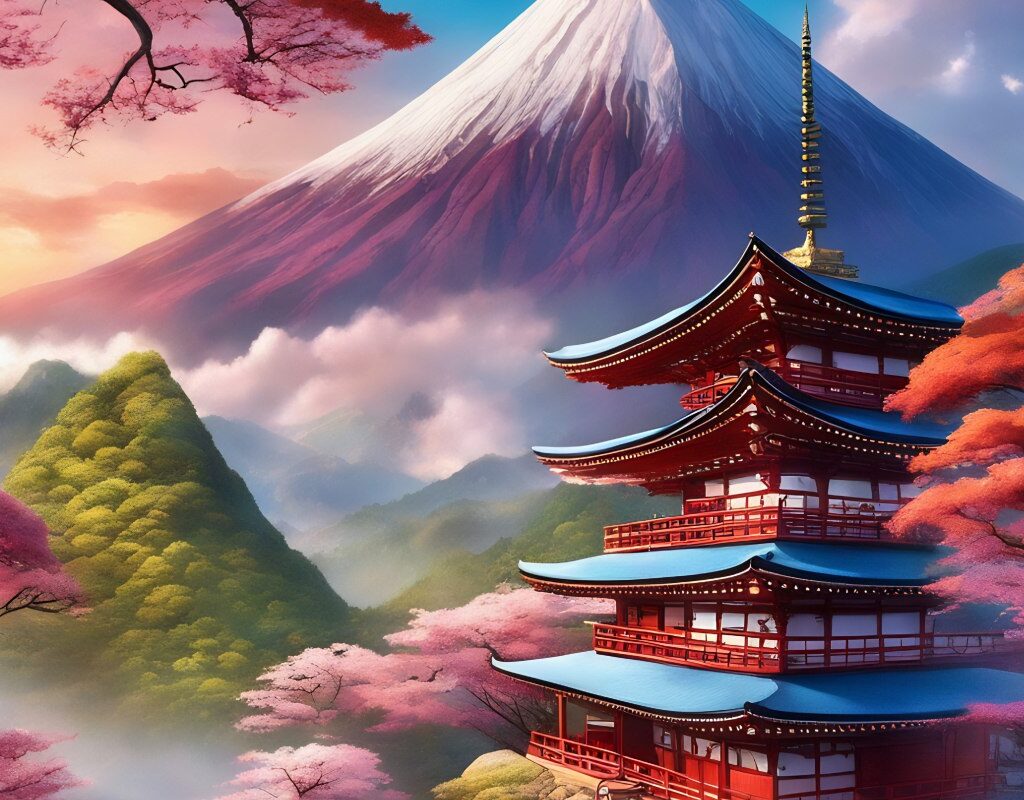The majestic Leshan Buddha, standing more than 70 meters tall, is the most imposing sacred image in the ancient world. Carved into the stone wall of a cliff, its creation dates back to 713 when a group of Buddhist monks began the sculpture in the hope that its divine power could calm the tumultuous rivers that converged on the site.
Discover the majesty of the Buddha of Leshan
Mist and mystery shroud the boat navigating the waters of Leshan as it makes its way toward the magnificence of the Buddha carved on Emei Mountain in western China’s Sichuan province.
During a moment of silence and contemplation, the viewer stands before the imposing seated Buddha, the largest stone image in the ancient world.
The majesty of the Leshan Buddha is a masterpiece of architecture and religiosity, standing some 70 meters tall and towering over the central face of the boulder.
This impressive statue is a clear reflection of Buddhist sentiment, which believes that greatness translates into beauty.
Every year, thousands of tourists and devotees come to this place to admire the presence of the Buddha, a symbol that acts as a bridge between our physical and spiritual worlds.
This is a wonder full of meaning, which generates respect and greatness in all who contemplate it. So much so that in 1996 Unesco declared it a World Heritage Site.
Historical clues and mysteries behind the creation of the majestic Buddha of Leshan
The carving on the rock began in the year 713, during the reign of Emperor Tang Xuanzong, belonging to the Tang Dynasty.
According to the story, since Leshan was a small fishing village surrounded by the dangerous Minjiang, Dadu and Qingyi rivers, where many ships used to be shipwrecked, its inhabitants believed that those waters were controlled by an evil spirit.
And it was then that the monk Haitong and his disciples decided to create a colossal Buddha at the confluence of these rivers to calm their turbulence.
After Haitong died, the statue remained half-built, and it was two of his disciples, Zang Chou and Wei Gao, who continued the complex work, which was completed some 90 years later.
The truth is that the fragments of rock that were falling on the banks of the river when the statue was carved managed to alter the currents and pacify their spirits…, although for the mystical believers, it was thanks to the power of the Buddha.
The majestic Buddha image carved on Emei Mountain
Emei Mountain, one of the four sacred sources of Buddhism in China, is about 4,000 meters above sea level. The majestic Buddha figure, carved into its cliff, was “wrapped” in a huge wooden temple at the time of its creation, with only his face uncovered.
Monks, who lived in small caves on the sides of the cliff, spent much of their time in prayer in the temple. In 1962, archaeologists working on maintenance discovered a cave in the chest of the Buddha, where they found iron and ancient bricks.
Imagine the atmosphere in that vast and peaceful space: music, chanting and praise in the presence of the huge image rising from the earth to the heights.
Some stories say that monks sat on the fingers of the Buddha to pray as if he were a living being, a being whose immensity knew no bounds.
During the Chinese Cultural Revolution, the prayer space behind the head of the Buddha was closed and the monks moved away from the mountain. Although they no longer live there, they continue to worship at the 30 temples in the region and visit the great image of Emei frequently.
The Legend of Maitreya: Discovering the Future of the Buddhist Faith
1,900 years ago, a great Buddhist master illuminated the way to escape worldly desires and attain nirvana. Although worshipped as a god by his believers, Siddhartha Gautama, known as Buddha, began to be depicted as a human being rather than an abstract figure.
This human representation of the sage and revered Buddha remains an integral part of Buddhist religious iconography to this day. Although Buddha manifests himself in many different forms, the figure of Maitreya has a particular significance.
He is said to be the successor of Siddhartha Gautama, the actual Buddha, who announced Maitreya long ago. Despite his significance, the arrival of Maitreya remains uncertain.
The legend has it that Maitreya Buddha will descend to Earth when the ancient Buddhist faith is worn out and the world is nearing its end, bringing with him complete enlightenment and teaching the way to the great truths.
His arrival is awaited by many believers, although his time of arrival is still unknown and remains uncertain.
The Leshan Buddha, the only religious figure that shows him seated on a chair with his hands resting on his knees, is an architectural marvel that has defied time for centuries.
However, although it has a complex internal sewage system that drains rainwater and slows its wear and tear, erosion can still be a threat to its physical integrity.
The turbulent waters of the three rivers that meet at its base have been undermining its foundations for centuries, eroding the monumental figure that stands proudly atop the mountain.
Even with the complex internal sewage system, designed to drain rainwater and slow its wear and tear, erosion remains a constant threat.
Despite a massive restoration in 2001, the statue has some dark spots and, along with the winds and rain, its image continues to deteriorate without remedy.
Exploring the majestic Emei Mountain in Leshan City: discovering the beauty under the sky
The city of Leshan does not have much tourist interest per se. The challenge there is to meet the great Buddha. “The mountain is Buddha and Buddha is the mountain,” reads a welcoming phrase on the cliff.
Majestic Emei Mountain, with its breathtaking natural scenery and abundant wildlife, is accessible only by sea. Visitors can arrive by local passenger boat or by private boat with a driver-guide, at a reasonable cost of $10 to $20.
Once disembarking at Emei Mountain, visitors are immersed in a world of natural beauty. Known as “the beauty under the sky,” “nature museum” and “Buddhist kingdom,” this mountain is famous for its steep, nine-turn staircase carved into the rock in a zigzag pattern that visitors must ascend.
Climbing up to the Maitreya Lookout: A Challenge with a Spectacular View
Each lap is more challenging than the last, making it a test for the most adventurous tourists. However, the effort is worth it, as the panoramic view from the top is spectacular.
Hundreds of steps lead up to the viewpoint, where the face of Maitreya is located. From this vantage point, Western eyes come across some details that are beyond their comprehension capabilities.
With a length of seven meters each, the ears of the Buddha embody the Eastern notion of beauty, a trait that can only be attributed to a highly developed human being.
The countenance of the Buddha, with its peaceful and transcendental gaze that seems to emanate from its half-closed eyes, conveys a sense of happiness, compassion and understanding.
With its dimensions reaching 50 feet in height, the imposing countenance of Maitreya Buddha is a testament to his highly developed brain and his path to enlightenment. The cone-shaped hairs crowning his head reflect his wisdom and understanding of the world.
Understanding the Buddhist Faith of Maitreya: Discovering the Promise of Spiritual Fulfillment through Prayer and Compassion
Followers of the Buddhist faith explain that the worship of Maitreya emphasizes the importance of prayer and the pursuit of a better life. His majestic and solemn image represents hope and the promise of spiritual fulfillment for those who follow his path.
Revered in the Buddhist faith, the spirit of Maitreya guides his followers along the path of contemplation and reflection, teaching them how to find order and generosity in their lives, and how to forge a more hopeful future for all humankind.
The doctrine of Maitreya emphasizes the importance of facing life with a positive attitude and a smile on one’s face.
This means embracing life’s challenges with an open and fearless attitude and always looking for ways to help others and make a positive difference in the world. For followers of the Buddhist faith, the spirit of Maitreya is a source of inspiration and a guide in their search for inner peace and spiritual fulfillment.
By embracing his message of kindness and compassion for others, they seek to find harmony and happiness in their lives and create a more prosperous and just world for all.
This religious icon, revered by Buddhists around the world, is considered a representation of wisdom and enlightenment. The Buddha is seen as a guide for those seeking inner peace and spiritual fulfillment. His serene and benevolent appearance is a reflection of the depth of his knowledge and compassion.




